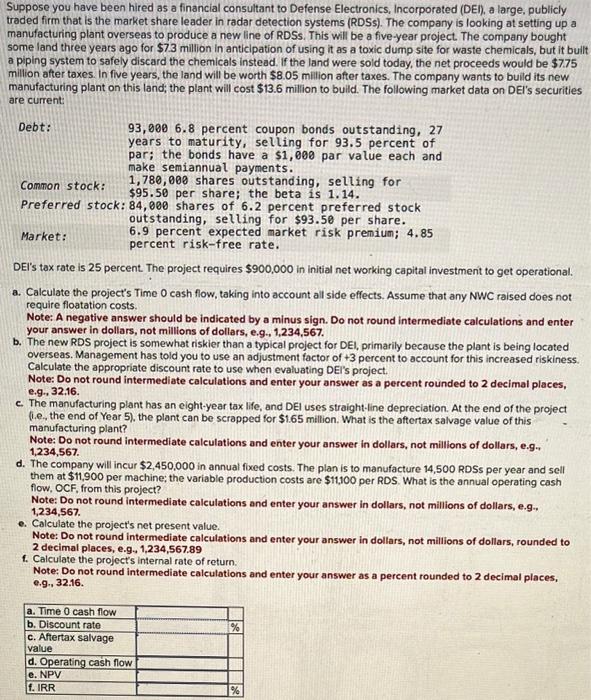Suppose you have been hired as a financial consultant to Defense Electronics, Incorporated (DEI), a large, publicly traded firm that is the market share leader in radar detection systems (RDSs). The company is looking at setting up a manufacturing plant overseas to produce a new line of RDSs. This will be a five-year project. The company bought some land three years ago for $7.3 million in anticlpation of using it as a toxic dump site for waste chemicals, but it bullt a piping system to safely discard the chemicals instead. If the land were soid today, the net proceeds would be $7.75 million after taxes. In five years, the land will be worth $8.05 milion after taxes. The company wants to build its new manufacturing plant on this land; the plant will cost $13.6 million to build. The following market data on DEl's securities are current: Debt: 93,0006.8 percent coupon bonds outstanding, 27 years to maturity, selling for 93.5 percent of par; the bonds have a $1,000 par value each and make semiannual payments. Common stock: 1,780,000 shares outstanding, selling for \$95.50 per share; the beta is 1.14. Preferred stock: 84,000 shares of 6.2 percent preferred stock outstanding, selling for $93.50 per share. Market: 6.9 percent expected market risk premium; 4.85 percent risk-free rate. DEl's tax rate is 25 percent. The project requires $900,000 in initial net working capital investment to get operational. a. Calculate the project's Time 0 cash flow, taking into account all side effects. Assume that any NWC raised does not require floatation costs. Note: A negative answer should be indicated by a minus sign. Do not round intermediate calculations and enter your answer in dollars, not millions of dollars, e.g., 1,234,567. b. The new RDS project is somewhat riskier than a typical project for DEl, primarily because the plant is being located overseas. Management has told you to use an adjustment factor of +3 percent to account for this increased riskiness. Calculate the appropriate discount rate to use when evaluating DEI's project. Note: Do not round intermediate calculations and enter your answer as a percent rounded to 2 decimal places, e.g. 32.16. c. The manufacturing plant has an eight-year tax life, and DEl uses straight-line depreciation. At the end of the project (i.e. the end of Year 5), the plant can be scrapped for $1.65 million. What is the aftertax salvage value of this manufacturing plant? Note: Do not round intermediate calculations and enter your answer in dollars, not millions of dollars, e.g. 1,234,567. d. The company will incur $2,450,000 in annual fixed costs. The plan is to manufacture 14,500 RDSs per year and sell them at $11,900 per machine; the variable production costs are $11,100 per RDS. What is the annual operating cash flow, OCF, from this project? Note: Do not round intermediate calculations and enter your answer in dollars, not millions of dollars, e.g., 1,234,567. e. Calculate the project's net present value. Note: Do not round intermediate calculations and enter your answer in dollars, not millions of dollars, rounded to 2 decimal places, e.9. 1,234,567.89 f. Calculate the project's internal rate of return. Note: Do not round intermediate calculations and enter your answer as a percent rounded to 2 decimal places, e.g. 32.16. Suppose you have been hired as a financial consultant to Defense Electronics, Incorporated (DEI), a large, publicly traded firm that is the market share leader in radar detection systems (RDSs). The company is looking at setting up a manufacturing plant overseas to produce a new line of RDSs. This will be a five-year project. The company bought some land three years ago for $7.3 million in anticlpation of using it as a toxic dump site for waste chemicals, but it bullt a piping system to safely discard the chemicals instead. If the land were soid today, the net proceeds would be $7.75 million after taxes. In five years, the land will be worth $8.05 milion after taxes. The company wants to build its new manufacturing plant on this land; the plant will cost $13.6 million to build. The following market data on DEl's securities are current: Debt: 93,0006.8 percent coupon bonds outstanding, 27 years to maturity, selling for 93.5 percent of par; the bonds have a $1,000 par value each and make semiannual payments. Common stock: 1,780,000 shares outstanding, selling for \$95.50 per share; the beta is 1.14. Preferred stock: 84,000 shares of 6.2 percent preferred stock outstanding, selling for $93.50 per share. Market: 6.9 percent expected market risk premium; 4.85 percent risk-free rate. DEl's tax rate is 25 percent. The project requires $900,000 in initial net working capital investment to get operational. a. Calculate the project's Time 0 cash flow, taking into account all side effects. Assume that any NWC raised does not require floatation costs. Note: A negative answer should be indicated by a minus sign. Do not round intermediate calculations and enter your answer in dollars, not millions of dollars, e.g., 1,234,567. b. The new RDS project is somewhat riskier than a typical project for DEl, primarily because the plant is being located overseas. Management has told you to use an adjustment factor of +3 percent to account for this increased riskiness. Calculate the appropriate discount rate to use when evaluating DEI's project. Note: Do not round intermediate calculations and enter your answer as a percent rounded to 2 decimal places, e.g. 32.16. c. The manufacturing plant has an eight-year tax life, and DEl uses straight-line depreciation. At the end of the project (i.e. the end of Year 5), the plant can be scrapped for $1.65 million. What is the aftertax salvage value of this manufacturing plant? Note: Do not round intermediate calculations and enter your answer in dollars, not millions of dollars, e.g. 1,234,567. d. The company will incur $2,450,000 in annual fixed costs. The plan is to manufacture 14,500 RDSs per year and sell them at $11,900 per machine; the variable production costs are $11,100 per RDS. What is the annual operating cash flow, OCF, from this project? Note: Do not round intermediate calculations and enter your answer in dollars, not millions of dollars, e.g., 1,234,567. e. Calculate the project's net present value. Note: Do not round intermediate calculations and enter your answer in dollars, not millions of dollars, rounded to 2 decimal places, e.9. 1,234,567.89 f. Calculate the project's internal rate of return. Note: Do not round intermediate calculations and enter your answer as a percent rounded to 2 decimal places, e.g. 32.16







